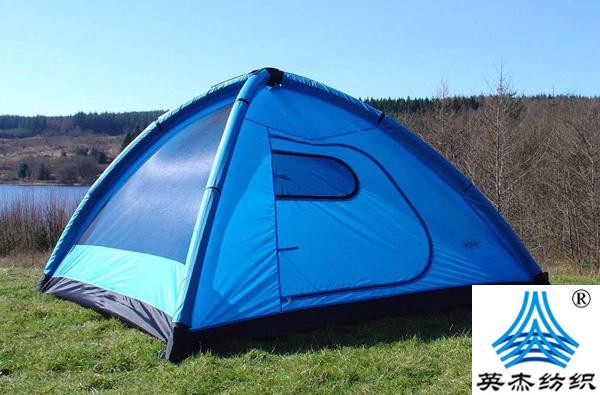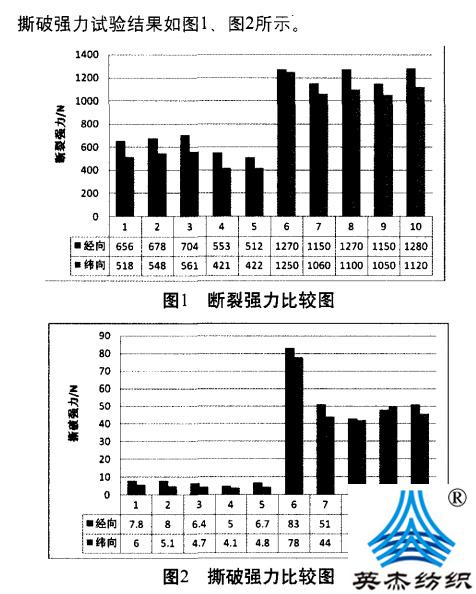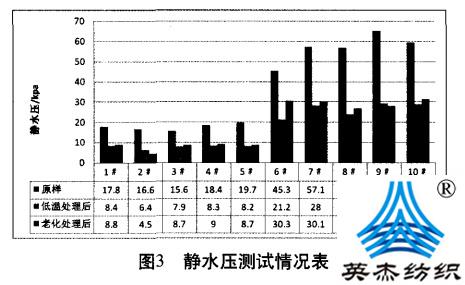Functionality and testing analysis of coated fabrics for tents
Functionality and testing analysis of coated fabrics for tents
Tents may be the earliest textiles used as building materials. They are simple and convenient. It is lightweight and has the functions of windproof, rainproof, snowproof, coldproof, dustproof, and mosquitoproof. The development of tourism today has promoted the development of tourism textiles, which has directly driven the substantial growth of tent sales in my country.

The main domestic testing standards related to tent fabrics include: international standard ISO 10966: 2005 “Textiles – Fabrics for canopies and camping tents – Specification” (Sports and Recreational Equipment – Fabrics for awnings and camping tents – Specification), national standard GB/T24139-2009 (PVC coated fabric waterproof Fabric Specification”, National Standard GB/T20463.1-2006 “Rubber or Plastic Coated Fabric for Waterproofing Part 1: Polyvinyl Chloride Coated Fabric” Ministry of Civil Affairs Industry Standard MZ/T0l1-2001 “L2m Single Tent for Disaster Relief”. However, there is currently no national standard for coated fabrics for tents in China. The items and index levels assessed by domestic and foreign standards are quite different, each has its own focus, and its scope of application is limited, leaving tent manufacturers confused. To a certain extent This has restricted the healthy and orderly development of the industry.
This article is based on the actual use of tent fabrics in my country. Ten tent coated fabric samples of different styles were selected according to the categories of light tents and heavy-duty tents, and the fabric characteristics and testing were analyzed, aiming to provide reference for the formulation of standards. 1 Materials and methods 1.1 Test materials The samples used in this test mainly include tourist tent cloth, disaster relief tent cloth and military tent tarpaulin from 2o14 to September (Part 2). According to the mass per unit area of the fabric, it is divided into: heavy tent fabrics (mass per unit area greater than 150g/m), light tent fabrics (mass per unit area less than 150g/m). The test weight is 1. 1.2 Test method Tent is an outdoor product. It needs to meet the requirements of complex outdoor environments such as sunlight and rain.

Therefore, in addition to regular performance, functionality also needs to be assessed. On the basis of referring to relevant domestic and foreign standards, this article extracts the assessment indicators of coated fabrics for tents from both conventional and functional aspects, including breaking strength, tearing strength, light color fastness, water color fastness, and hydrostatic pressure , surface moisture resistance, flame retardancy, and anti-aging properties, a total of 8 indicators. The method used in the test is shown in 2. 2 Results and discussion 2.1 Conventional performance The conventional performance of coated fabrics for tents mainly considers four indicators: breaking strength, tearing strength, light color fastness, and water color fastness.
2.1.1 Breaking strength and tearing strength Because the coated fabric for tents is in a covering state or hanging state during use. To withstand various tensions from metal brackets, ropes, etc., the fabric must have greater strength, mainly considering two indicators: breaking strength and tearing strength. Breaking strength refers to the strength when the yarn is completely broken when directional stretching is applied to the warp or weft direction of the fabric. Tear strength refers to the large external force required for the yarns to break sequentially when the fabric has tears. The greater the breaking strength and tearing strength. The stronger and more durable the fabric, the better it is at resisting wind and pressure. The breaking strength and test data can be seen. The breaking strength of lightweight tent fabrics (group 1≠}~5): the warp direction is in the range of 512N to 704N, and the weft direction is in the range of 421Ng0561N; the breaking strength of heavy-duty tent fabrics (group 6#-l0): the warp direction is in the range of 1150N to 1280N, The weft direction is in the range of 1050N~01250N; the breaking strength of the test sample is much greater than the requirement of ≥150N for general fabrics. It can be seen from the experimental data of 2. The tearing strength of lightweight tent fabric (1#-5#): the warp direction is in the range of 5N~IJ8N, and the weft direction is in the range of 4N to 8N; the tearing strength of heavy-duty tent fabric (6#-10≠): the warp direction is in the range of 43N to IJ8N 83N interval, and the latitudinal direction is located in the 42NN78N interval.
The tearing strength of lightweight tent fabrics is poor, and the tearing strength of heavy-duty tent fabrics is much higher than the requirement of ≥10N for general fabrics. 2.1.2 Color fastness to light and color fastness to water No matter what type of product the coated fabric for tents is made into. All tents will be washed by light and rain during use, and the coated fabrics used in tents do not come into direct contact with the human body. Therefore, the two indicators of light fastness and water fastness are mainly assessed. The specific test methods are GB/T8427 method 3~Ft]GB/T5713. See 3 for the test results. From the test data, it can be seen that the color fastness of the coated fabrics for tents is relatively good. The light color fastness of the 10 samples tested is not lower than level 4-5, and the water fastness is not lower than level 3-4. The light fastness and water fastness test samples of lightweight tent fabrics (1~5≠}) and heavy tent fabrics (6#-10≠}) are all at a relatively high level, with no obvious difference. They are both higher than general textile products. Standard first-class product requirements.

2.2 Functionality 2.2.1 Waterproof tent coated fabric is exposed to the outside due to its use environment. Often exposed to rainwater, it is required to have good waterproof properties. There are many test methods for measuring the waterproof properties of textiles at home and abroad, but they are mainly divided into two aspects. One is to measure the resistance of textile surfaces to being wetted by water – surface resistance. Moisture. The other aspect is to determine the resistance of textiles to water penetration – hydrostatic pressure. 2.2.1.1 Still waterThe hydrostatic pressure measurement is carried out in accordance with the test standard: GB/T4744-1997 “Hydrostatic Pressure Test for Determination of Water Permeability Resistance of Textile Fabrics”. The water pressure rising speed adopts 6kPa/min. The coated fabric for tents will often be damaged by wind, sun, rain, etc. during use, and the coating will be damaged or peeled off, affecting its durable use. Therefore, in addition to considering the original hydrostatic pressure, it must also be assessed Humidity resistance after low temperature and aging. The test results are shown in 3. It can be seen from 3 that the hydrostatic pressure test values of the 10 samples are all at a relatively high level. The hydrostatic pressure of the heavy-duty tent coated fabric is significantly higher than that of the lightweight tent coated fabric. The lightweight tent coated fabric (1≠}~5# ) The original hydrostatic pressure is concentrated at 15.6kPa~019.7kPa. The heavy-duty tent coating fabric (6#-10 mix) the original hydrostatic pressure is concentrated at 45.3kPa~059.3kPa. After the samples were processed at low temperature and aged, the hydrostatic pressure of both heavy-duty and lightweight coated fabrics dropped significantly. The hydrostatic pressure value is only about half of the original value.
2.2.1.2 Surface moisture resistance The surface moisture resistance was measured in accordance with GB/T4745-1997 “Water Test for Determination of Surface Moisture Resistance of Textile Fabrics”. The test results are shown in 4. According to the test sample results, the moisture resistance of the coated fabric for tents is relatively good. The moisture resistance level of the 10 samples tested is not less than level 3. Light tent fabrics (1#-5#) and heavy tent fabrics (Group 6#-10) The surface moisture resistance properties are all at a relatively high level, with no obvious difference. The above 10 samples were washed, aged, and treated at low temperature before being tested for surface moisture resistance. It was found that the water staining levels of the 10 samples were all reduced to level 1. That is, the surface moisture resistance properties are lost. 2.2.2 Flame retardancy Based on the safety of use, the coated fabrics used in tents are required to have good flame retardancy. Flame retardancy can be obtained by selecting flame retardant fibers and flame retardant base fabrics. This can also be achieved by adding flame retardants to the coating agent. The Ministry of Civil Affairs’ industry standard “12m Special Single Tent for Disaster Relief” stipulates that tent fabrics should meet the damage length ≤ 150mm and the afterburning time ≤ 15s. Smoldering time ≤15s.
In this article, the coated fabrics used in tents are implemented accordingly. The flame retardant performance is measured according to the test standard: GB/T5455 “Vertical Method for Testing the Combustion Performance of Textiles”. The sample test results are shown in 5. Most samples can meet the requirements of this indicator. 2.2-3 Aging resistance Due to the usage characteristics of tent coated fabrics, it should have good aging resistance. However, there are no assessment requirements for this item in relevant domestic and foreign product standards. The measurement of anti-aging performance is carried out according to method B in FZ/T01008-2008. 70. C aging 168/1\hours. The determined index is that the sample does not become brittle, sticky, delamination, or cracked after the aging test. After testing and verification, more than 90% of the samples can meet this indicator requirement. 3 Suggestions for the formulation of standards 3.1 The formulation of relevant standards for coated fabrics for tents. It should include indicators related to the general performance and functionality of the fabric. 3.2 Routine use performance is specifically stipulated according to the purpose. The recommended range of specific indicators is: the light and color fastness of coated fabrics for heavy and light tents are not less than level 4, and the water resistance and color fastness are not less than level 3-4; breakage The strength is not less than 150N; the tear strength of coated fabrics for heavy-duty tents is not less than 15N, and the coated fabrics for light tents are not assessed.
3_3 Carry out relevant functional testing according to the characteristics of the product. Recommended range: The hydrostatic pressure of coated fabrics for heavy-duty tents is not less than 30kPa, and the hydrostatic pressure of coated fabrics for light-duty tents is not less than 12kPa: the surface moisture resistance of coated fabrics for heavy-duty and light tents is not less than level 3; heavy and light tents All coated fabrics used in tents should meet the requirements of damage length ≤150mm, afterburning time ≤15s, and smoldering time ≤15s. qwrewqgref
Disclaimer:
Disclaimer: Some of the texts, pictures, audios, and videos of some articles published on this site are from the Internet and do not represent the views of this site. The copyrights belong to the original authors. If you find that the information reproduced on this website infringes upon your rights, please contact us and we will change or delete it as soon as possible.
AA








